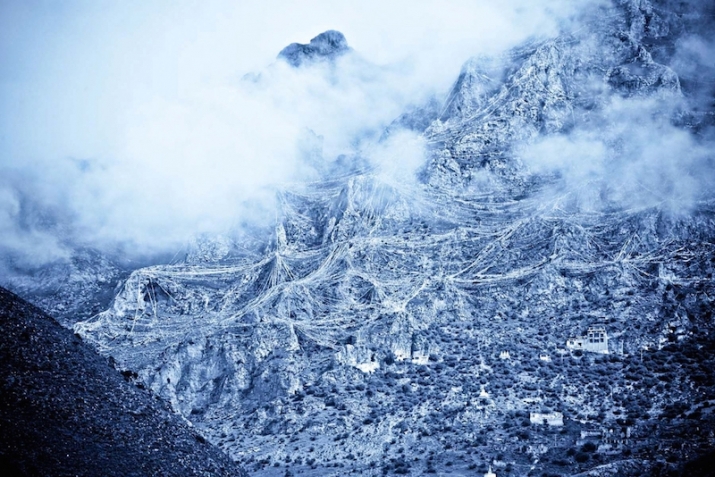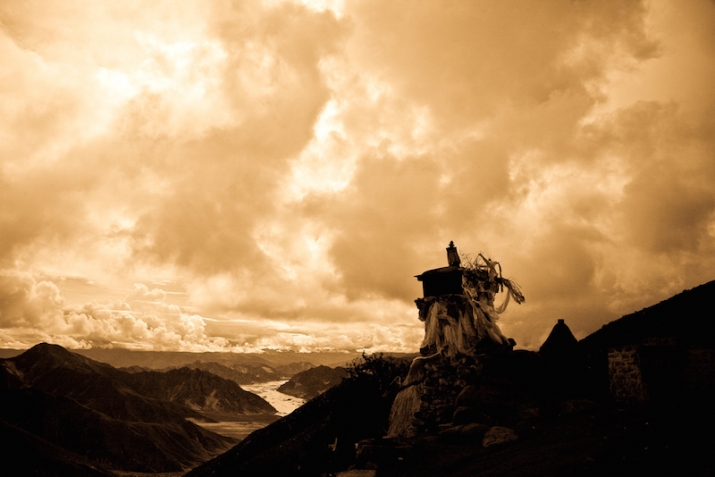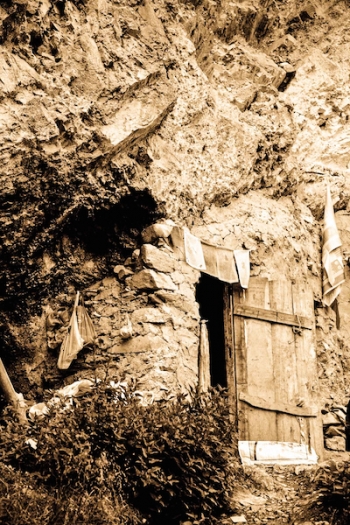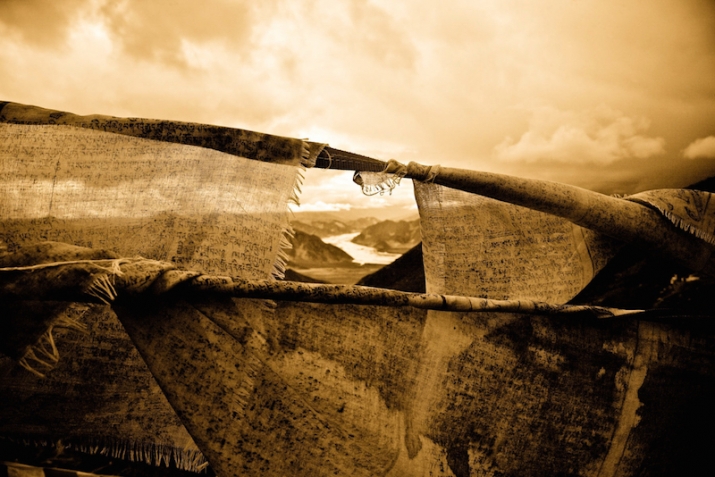Built beneath, and into, the cliffs are a myriad of hermitages where masters, yogis, and yoginis have practiced in solitary retreat for over 1,000 years, and are still doing so today. Entering these hermitages, caves, and shrines and meeting those that live and practice there afforded a direct glimpse of a quality of dedication and practice that one intuitively feels exists, but rarely encounters in the modern world. One cannot adequately describe the look in the eyes or the gentle smiles of the retreatants, the whole aura of the context of these encounters. No common words were shared, but a humanity and warmth of being that was as profound as it was simple. From these encounters, I continued along the winding pathways through the hanging prayer flags on into Guru Rinpoche’s cave at last, and to the view it offered down into the green valley, the wide world, below. Footprints in stone. A heartbeat within.
FEATURES|COLUMNS|Dharma Eye (inactive)
On Pilgrimage: A Journey through Tibet (part 1)
Buddhistdoor Global | 2015-01-16 |
 "Drak Yerpa I"
"Drak Yerpa I"Pilgrimage is a mysterious thing. It has a very simple outer level that is sheerly pragmatic. One makes a journey to a particular place in a particular timeframe, with all the logistics involved. And yet . . . there is something that makes a pilgrimage different than most journeys or ordinary travel. Somehow a transformation occurs, one similar to that which takes place in committed, long-term meditation practice. One’s outlook changes. The place one looks from is altered somehow; everything is seen differently. This involves a transformation not only in perspective, but in the very clarity with which one sees, with which one acts, and with which one experiences the world.
At least, that was my experience from a pilgrimage through Tibet to circumambulate Mount Kailash in the company of Venerable Tsoknyi Rinpoche and about another 60 of his students in 2007. What are the factors involved? Yes, there are the blessings of an authentic teacher; there are the qualities of sacred sites that have been blessed by great practitioners of the past. There are the aspirations that led one to undertake the journey in the first place and the degrees of surrender involved, both outer and inner, and then all the rigors of the journey itself. No magic wands here: the transformation is like a birth and a death at once, with all the challenges that they naturally involve. One discovers one must eventually let go (and usually of much) if one is ever to reach one’s destination. The comfort zone has no space, no ticket. One must step beyond what is known.
 "Pilgrimage"
"Pilgrimage"It was also a matter of stepping into a dream to photograph sacred sites, which had long been with me for reasons I have never fully understood—rather on the same level as breathing; it’s always been there. After years of studying and glimpsing Tibet and the lives and teachings of its great mahasiddhas (“great accomplished practitioners”), diving into the stories of masters of liberation and the sites where they practiced, from where they transformed themselves and the world in which they lived, I would now approach these very places, with both exhilaration and trepidation. Places such as Lhasa, Drak Yerpa, Gangri Tokar, Samye, Chimphu, Gyantse, Tingri, and the long stretches to the holy mountain, Mount Kailash, which has been circumambulated for over a millennium by devoted pilgrims on an established route around the mandala of this unique solitary peak in far western Tibet.
What was discovered? Mostly I remember friendships. The bonds, the dialogues, the absurdities of fellow travelers, fellow practitioners, fellow pilgrims. There was humor. And the vast awe-inspiring locations that we entered or—quite often through necessity—climbed up to. On the first days in Lhasa, after a flight from Kathmandu, while many in the group rested, acclimatized to the high altitude, and explored Lhasa and its temples, a small group of us pilgrims journeyed a few hours outside the city to the Drak Yerpa cave complexes one day, and to the sacred mount of Gangri Tokar the next.
Drak Yerpa houses the practice caves of several of the foremost masters in Tibetan Buddhist lore, Padmasambhava (Guru Rinpoche), Yeshe Tsogyal, Atisha, and more. As one turns the corner into its valley, hidden from Lhasa, one sees rocky cliffs surging into the sky, with what looks like a vast network of spider webs linking and interweaving through the cliffs. Only as one gets closer is one able to discern that these are in fact millions of prayer flags, stretching from heights and locations on the rocks that it is simply inconceivable for human beings to have reached. It’s an awesome sight, not to be forgotten.
 "Yogini's Cave"
"Yogini's Cave"How could the few hours there even be considered to have taken place in a day? A lifetime? This is a hint of the nature of pilgrimage. In a few hours of simple steps, simple encounters, lifetimes enter; one’s life opens.
 "Oddiyan's Gate"
"Oddiyan's Gate"The following day, after a rest in Lhasa, our small group expanded as we journeyed to Gangri Tokar, up a side valley a few hours south along the Kyichu River, which flows through Lhasa and eventually joins the Tsangpo on the water’s quest towards distant seas. After driving a few hours along the river, we turned into this side valley and approached Shuksep Nunnery, the home of Shuksep Jetsunma, one of the greatest yoginis of the past century. From here we would ascend two hours up the valley in a light rain to the hermitage of Gyalwa Longchenpa, the great Dzogchen master, often referred to as the second Buddha. This is the site where he composed his great Seven Treasuries, perhaps some of the most sublime words ever put to page, in any tradition, and sometimes rumored to have been composed by dakinis. As one reaches the level of this small, remote hermitage high above the world, a view opens out above ridge after ridge, and down to the great rivers flowing through the valleys below. A rainbow quivers around the sun. A few birds alight and glide in the wind above the ridges. Prayer flags flutter. Sky. Cloud. Breath.
There is a slight hesitation, right before that first step to descend and return to the world. A lifetime to reach this place, this view, rarified and unique, to which one may never return. There is something precious. In the acceptance that it is time to return to the world. With a jewel within.
Parts 2* and 3 of this series will continue over the next months with installments on Samye-Chimphu in Central Tibet and the actual circumambulation of Mount Kailash.
*See On Pilgrimage: A Journey through Tibet (part 2); and Michael Ash: The Tibet Pilgrimage Gallery (Central Tibet)
*See On Pilgrimage: A Journey through Tibet (part 2); and Michael Ash: The Tibet Pilgrimage Gallery (Central Tibet)
Michael Ash is the founder of Dharma Eye, a Buddhist photographers' collective. For further information, see the Dharma Eye website.

Comments:
Share your thoughts:













